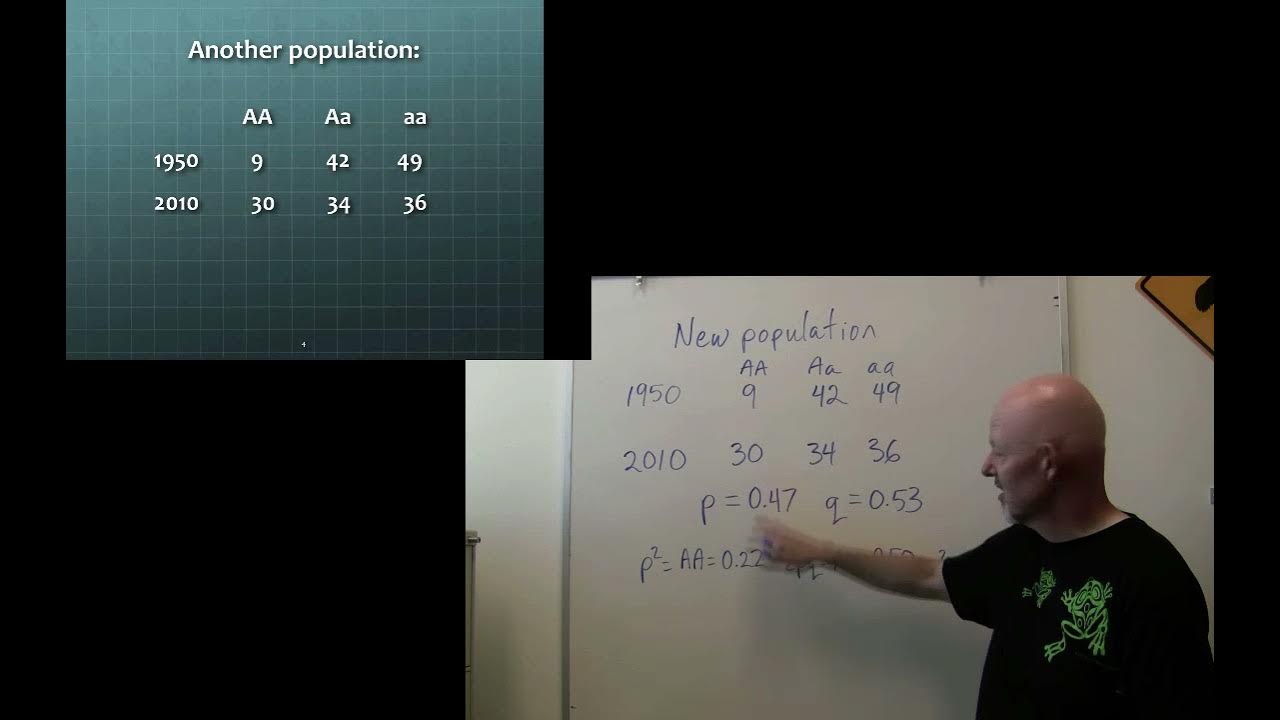Genetic Drift
Summary
TLDRThis video explores genetic drift, a random process that causes changes in allele frequencies within a gene pool. It discusses how small population sizes can lead to the loss of genetic diversity, exemplified through the bottleneck effect (like the Northern Elephant Seal's near extinction) and the founder effect (as seen in Pingelap’s isolated population). Using simulations and real-world case studies, the video demonstrates how genetic drift influences evolution, with significant implications for species' adaptability and survival. The speaker emphasizes the role of random chance in shaping genetic diversity and evolutionary outcomes over time.
Takeaways
- 😀 Genetic drift refers to random changes in allele frequencies in a population's gene pool, often due to chance events.
- 😀 Allele frequencies are represented by the p (dominant) and q (recessive) values in a gene pool, which can fluctuate over time.
- 😀 Random changes in allele frequencies are more significant in smaller populations, as each individual has a larger impact on the gene pool.
- 😀 Genetic drift can lead to the elimination of certain alleles in a population, as demonstrated by the shift from equal allele frequencies to one dominant allele over time.
- 😀 A population simulator can demonstrate genetic drift by showing how allele frequencies change over generations in different population sizes.
- 😀 Larger populations show less genetic drift due to the law of large numbers, which makes random changes less likely to have a big impact.
- 😀 The bottleneck effect occurs when a large population is reduced to a small size, leading to a loss in genetic diversity. An example is the Northern Elephant Seal.
- 😀 The founder effect happens when a small group of individuals starts a new population, leading to a limited gene pool and potential for high frequencies of specific traits, as seen in Pingelap.
- 😀 The bottleneck effect can have long-term consequences, such as reduced fitness and increased susceptibility to environmental changes, as shown in the Northern Elephant Seal's skull asymmetry.
- 😀 The founder effect in Pingelap led to a high prevalence of a rare form of colorblindness in the population, demonstrating how chance genetic traits can become widespread in isolated communities.
Q & A
What is genetic drift?
-Genetic drift is the random change in allele frequencies within a population's gene pool due to chance events. It can lead to the loss or fixation of alleles, and it is more pronounced in smaller populations.
How does genetic drift differ from natural selection?
-Unlike natural selection, which causes changes in allele frequencies based on fitness advantages, genetic drift occurs randomly, without regard to whether an allele has a survival or reproductive advantage.
What is the impact of population size on genetic drift?
-Smaller populations experience stronger genetic drift, with more noticeable fluctuations in allele frequencies. In larger populations, genetic drift has a less significant effect due to the law of large numbers.
What are the two main types of genetic drift discussed in the video?
-The two main types of genetic drift are the bottleneck effect and the founder effect. The bottleneck effect occurs when a population undergoes a sharp reduction in size, while the founder effect happens when a small group of individuals establishes a new population.
What is the bottleneck effect, and how does it affect genetic diversity?
-The bottleneck effect occurs when a population is drastically reduced in size, often due to a catastrophe, resulting in a loss of genetic diversity. Although the population may recover, its genetic makeup is significantly reduced.
Can you provide an example of the bottleneck effect from the script?
-An example of the bottleneck effect is the Northern Elephant Seal, whose population was nearly driven to extinction due to hunting. Although the population has since grown, it has much lower genetic diversity than before the bottleneck.
What is the founder effect, and how does it work?
-The founder effect occurs when a small group of individuals breaks off from a larger population to form a new one. Over time, the new population may show different genetic characteristics from the original group, often due to chance.
How did the founder effect manifest on Pingelap Island?
-On Pingelap Island, after a typhoon reduced the population to only 20 people, the founding population carried a genetic mutation for complete colorblindness. This trait became more prevalent in the population due to the small size and isolation of the group.
What does the law of large numbers have to do with genetic drift?
-The law of large numbers suggests that in larger populations, genetic drift has less effect because the allele frequencies are less likely to fluctuate dramatically due to random events. In smaller populations, random changes in allele frequencies are more pronounced.
How can genetic drift lead to the elimination of certain alleles from a population?
-Genetic drift can lead to the elimination of alleles due to random events that disproportionately affect certain individuals in a population. For example, if a population of tortoises is isolated on an island, random genetic changes could lead to the loss of a particular allele, such as the allele for a certain shell color.
Outlines

هذا القسم متوفر فقط للمشتركين. يرجى الترقية للوصول إلى هذه الميزة.
قم بالترقية الآنMindmap

هذا القسم متوفر فقط للمشتركين. يرجى الترقية للوصول إلى هذه الميزة.
قم بالترقية الآنKeywords

هذا القسم متوفر فقط للمشتركين. يرجى الترقية للوصول إلى هذه الميزة.
قم بالترقية الآنHighlights

هذا القسم متوفر فقط للمشتركين. يرجى الترقية للوصول إلى هذه الميزة.
قم بالترقية الآنTranscripts

هذا القسم متوفر فقط للمشتركين. يرجى الترقية للوصول إلى هذه الميزة.
قم بالترقية الآن5.0 / 5 (0 votes)






